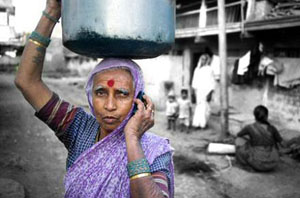
THEN AND NOW
Author - Nandu Madhekar

|
THEN AND NOW
|
One late afternoon in 1994, there was some strident knocking on our office door. I opened it, and saw a Mrs Joshi (name changed) standing outside - leading a team of 5-6 guys. They literally pushed me aside, and entered the office. I was quite intimidated.
‘We know that you have a long cord’, she declared. I was baffled. What the heck was a long cord? Without waiting for a response, her men started searching the office. They located our phone and examined it. ‘No long cord, madam’, they reported - a bit disappointed. ‘Humph!’ Mrs Joshi snorted. Without a hint of apology, the team turned around and left. There was no point in protesting this intrusion. In fact, any protest could be construed as obstruction of justice.
It turned out that some pompous fart in the hallowed Department of Telecommunications (DoT) had decreed that cords (cables that connected the phone jack and instrument) could not be longer than 3 meters. Anyone with a longer cord could be punished, and we were suspected of contravening the rules.
“Pray, why”, you may ask, “couldn’t the cord be longer than 3 meters?” The same question bugged me. And therein lies a tale….....
For decades, the great socialist state of India had decided that telephone services would be a government monopoly. DoT was grossly overstaffed, and most of its budget went for salaries. There was little left for expansion of network. No one was accountable, and very few did any work. So, while rest of the world raced ahead, we had all of 5 million phones for 850 million people, as late as 1991!
This scarcity had several repercussions. Tariffs were sky-high, it could cost up to Rs 90 a minute (300 in today’s rupees) to call Chennai from Delhi. The phones were, inevitably, rationed. Members of parliament and state legislatures gave themselves the highest priority. They could not only appropriate phones for themselves, but also nominate others for out-of-turn allotments. For some inexplicable reason, retired government employees also had priority. Ordinary folk, at the bottom of the hierarchy, had to wait up to 8 years to get a phone. Of course, those who greased palms got to jump the queue.
Some lucky phone-owners charged people to use their phones, and actually made a decent living off it. Others, who had a phone that they did not need, transferred it for money. DoT was supposed to approve all such transfers, but this simply meant another source of graft.
Now, here is where the long cord comes in. Often, several small businessmen shared an office. It would have one phone, with a long cord. The instrument could now be passed from one desk to another. Fewer people needed their own phones, and this reduced the revenue and kickbacks that DoT could make. So, DoT banned ‘long cords’!
The net result was that, if you wanted to move your own phone from your own living room to your own bedroom - you had to apply to DoT, pay Rs 600 as (official) charges, plead with the concerned persons for 4-5 months, tolerate their arrogance and grease several palms. If an office was being shifted, it meant loss of business for several months. You could live without a phone at home, but businesses needed phones. So, kickback rate for transferring commercial phones was commensurately higher. I have personally experienced all of this.
This is only a small peek into how India worked, the story was repeated everywhere. An industrial enterprise could be started only by obtaining a ‘license’ - by paying the proper black-market price. It could be sustained only by bribing an army of inspectors – from pollution control, factory, taxation and labour departments. Once this environment was ‘managed’, producers were well sheltered by the license raj. The quality or price of their products did not matter.
Such was the Indian establishment that throttled enterprise, and held back development. I hold it squarely responsible for the poverty that has haunted India for decades.
Mercifully, Indian economy opened up after the financial crisis of 1991. For all their other faults, BJP-led government opened telecom to private enterprise. We were also fortunate that wireless cell phone technology appeared. It allowed entrepreneurs to skip the rotten fixed-line infrastructure. After some hiccups, licensing terms were ironed out and telecommunications has now really taken off.
Today, it costs around one rupee a minute to call from any place in India to any other place. Amazingly, Indian entrepreneurs still coax profits from such low tariffs. Plumbers, electricians, carpenters and roadside vegetable vendors take orders on their own phones. There is no waiting list any more - you can buy a phone off the shelf. The number of phones has now crossed 260 million, and is growing at an incredible 8.5 million per month. We expect to cross 500 million phones by the end of this decade. Only China has more phones than India, and our growth rate is the highest in the world. Indeed, Indian companies are now making bids for the $20 billion MTN of Africa.
This story has a happy ending. There are other happy endings too – industrial licensing is over, financial sector has been largely reformed and roads are improving noticeably. I can actually drive from Pune to Mumbai in 2 hours, one-third the time it took few years ago. And, I hear Mrs Joshi got fired for corruption!

But we are not done yet. A handful of communists can still hold the country to ransom. Labour market is restrictive. Education is crying out for reform. Latent social tensions are rising to the surface, but I believe our democracy can deal with them. Keep fingers crossed, and watch this space!
Nandu Madhekar
9 July 2008
Please write to me your comments about the above article.
 nandu.madhekar@gmail.com
nandu.madhekar@gmail.com

Nandu Madhekar graduated from IIT Bombay in 1980. After graduation, he went to USA, where he completed M.S. He was pursuing Ph.D. when he felt that he could no longer tolerate living like an outsider. He decided to be where his heart was and returned to India. Now, he is based in Pune and is a well-known consultant advising chemical and pharmaceutical factories.

Website developed and managed by

MF-104, Ajay Towers, E5/1 (Commercial),
Arera Colony,
Bhopal - 462016 INDIA

© All Rights Free